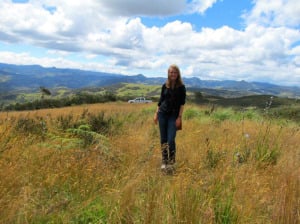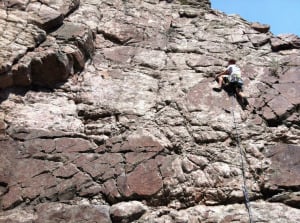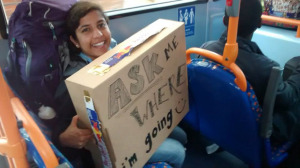Although the form a student must submit to take time away from Stanford is relatively straightforward – two pages requiring a few signatures – the decision to submit it can be one of the most difficult choices the student has ever made.
To support the students that do eventually make that decision, Madeline Lisaius ’18 co-founded Bridging the Gap, a new student group that hopes to create a community for students who have spent time away. Lisaius herself took time off between high school and college as a result of a long battle with illness.
“Taking a bridge year, I expected to feel behind on school work, to feel disconnected from old friends and challenged to make new ones,” she said.

(Courtesy of Madeline Lisaius)
Lisaius spent the last month of her high school senior year and part of that summer in the hospital working to return to health both physically and mentally. Later in the year, she spent time in Ecuador working at an endangered animal rescue shelter and in Washington State collecting data for a water resource project.
Drawing on that experience once she came to Stanford, Lisaius approached Student Activities and Leadership (SAL) about starting the group, and SAL connected her with Jack Lane ’16, a student who took time off between sophomore and junior year at Stanford and had come up with a similar idea independently.
In response to what they saw as an unfilled need, Lisaius and Lane founded the group with about 20 other students who have taken time away from the Farm.
“I haven’t felt supported by Stanford in coming back,” Lane said. “I felt the impetus was on me to figure everything out again.”
The group hopes to act as a support center for students returning from time off, a forum for sharing experiences, a launchpad for students interested in taking time off in the future and a place to discuss non-traditional and experiential learning. The group has partnered with the Stanford Storytelling Project to tell stories of students who take time off and spread that information to interested students.
“Coming to Stanford, I remember thinking many times ‘I wish there was a community for people who have taken time away like me,’” Lisaius said. “Finding other students who had taken time off was so refreshing, and I was inspired to create some type of group that could link this community on campus.”
The group may serve as an avenue for interested to students to learn more in depth about the experience than mere common perception.
“One perception is that taking time off will somehow entail missing out, or a lack of experience,” he said, “I had quite the opposite experience; I don’t feel like I missed anything important at school in the time I was gone, social, academic, or otherwise, and I wouldn’t trade experiences for anything.”

(Courtesy of James Cranston)
James Cranston ’16 took a year off between high school and college for personal and family reasons. He began his freshman year at Stanford right out of high school, but decided three weeks into college to defer a year.
One thing that he hopes Bridging the Gap will emphasize is that it’s okay to make decisions about your life that are not based on input from anyone else.
“It can be really hard to leave Stanford, but it made perfect sense in the end,” Cranston said. “I would encourage everyone to look within and see what is the right decision for them.”
Bridging the Gap is serving a growing community. Over the past decade, an average of approximately 320 Stanford undergraduate students per calendar year have taken time off for a wide variety of reasons, ranging from financial difficulty to searching for life’s purposes.
Financial factors
The costs of attending a private university like Stanford have long contributed to students’ decisions to take time off.
“My parents weren’t going to be able to pay for my junior year, so I had to take a year off to see what my options would be,” said Bob Thornton ’16, who had come to Stanford in 1985 and left after his sophomore year in 1987.
Thornton had begun taking Russian at Stanford initially, so he enlisted in the Navy and went to the Defense Language Institute south of Stanford in Monterey, California.
“It was an amazing experience [with the Navy],” Thornton said. “That’s why I stayed in for 26 years.”
He spent many years stationed overseas – three years in Spain, one year in Turkey, one year in Afghanistan and two years in London – and was able to see many facets of the Navy, spending time on submarines, aircraft carriers, patrol craft, S-3 jet aircraft and P-3 recce aircraft.
Like Thornton, Frederick Irving ’15 – who began his undergraduate career at Stanford in 1981 and left in 1983 – left for family reasons and financial pressure that were affecting his studies.
“They took away my focus, and I wanted to make room for someone else at Stanford,” Irving said.
After his 29-year leave, Irving came back to campus in 2012 because his 15-year job as an IT manager for J.P. Morgan was outsourced.
“I realized you can have your job taken away, but not your education,” he said.
In his time away, Irving married to his wife of 27 years, who he had met at Stanford. They had two kids and “lived the American Dream,” according to Irving. His daughter is now a civil engineer with a degree from Cornell, and his son is in the last year of his physics degree.
Despite the history of Thornton, Irving and others who have taken leaves from Stanford for financial reasons, some students in similar situations today are hesitant to pursue that option.
“Some students think all 12 quarters of their financial aid must be taken in a row and that there would be some penalty for taking a break,” said Mary Morrison, director of funds management in the Office of Financial Aid.
In reality, all students on financial aid apply for assistance annually. The amount of aid a given student needs the year they return to Stanford may be more or less than the aid they received previously, but is not affected by time off, Morrison said.
Wanderlust
During his year off, Lane worked for a lepidopterist studying butterflies in the Rocky Mountains, spent time at home in Atlanta, traveled around Europe, Thailand and India and worked on campus at the outdoor center and DisGo.
“I had recently quit the swim team, and I felt like I needed more than the summer to reorient myself to Stanford,” Lane said. “It became obvious to me that I needed more academic direction in order for school to be worthwhile, and I also just wanted an adventure – which may have been the best reason.”
Josh Stanley also decided to see new parts of the world during his time off before attending Stanford, leaving for the Army two weeks after graduating high school. He knew he wanted to go to college someday, just not right away.
“I couldn’t stand the thought of sitting behind a desk for four more years, and needed to get out and live – to have an adventure,” he said. “I had plenty in the Army.”
The time he took between high school and university helped him realize that the most important life lessons cannot be taught in a classroom. He fought in Iraq and Afghanistan, and cited those as some of the best times of his life.
“Granted, I’m looking back through rose-tinted lenses, but they were thrill rides most wouldn’t board, and it enabled me to reach a level of self-awareness most never get to,” he said.
Annie Dillon ’16 grew up traveling with her family and wanted to have similar experiences on her own. The idea to take time off from Stanford occurred to her as a freshman, and she ended up taking a year off after her sophomore year. This halfway point felt natural, she said.
She spent time in Budapest on a SIG fellowship, worked on a small family farm outside of Ashland, Oregon, traveled around Spain, lived in Beijing, worked for a Swiss urban farmer and tutored English.
“Stanford can be very insular,” said Dillon, who now studies earth systems. “It felt good to, for a year, be interacting with people who weren’t in that circle, wouldn’t even ask where I went to school and did not cite Stanford as my defining feature.”
Needing a breather

(Courtesy of Alka Nath)
For Alka Nath ’16, who also took time off after her sophomore year, the choice to take a break from school was driven primarily by her experiences at Stanford. She said that she needed to build up her self-confidence and confirm to herself that she was not inferior to her classmates – just different.
“When you’re at Stanford, people talk about duck syndrome and compare themselves to each other,” she said. “They’re not used to being in a place where everyone is the best at something.”
Nath admits that she didn’t have a plan at first, and that her parents didn’t understand the purpose of her gap year. She chose to spend time in the Semester at Sea program and participate in the Red Bull Challenge in Europe, and said that her time off helped her focus on what was important to her – a stark contrast to her freshman year.
“I tried nine billion things and didn’t commit to any of them,” Nath said of her first year on the Farm.
Now, four of Nath’s friends are taking time off after seeing how beneficial it was to her.
Resources upon returning to the Farm
Lisaius said that before she returned, she worried how others would perceive her. She has found that those fears were unsubstantiated.
“I worried that it would be ‘weird’ to be older, and that peers might think of me as a slacker,” Lisaius said. “Now, I feel more motivated and genuinely interested in learning that I can remember, and I have been able to connect with others in more meaningful ways than before.”
One of these support organizations is the Stanford Returning Students Association, which was founded by Sally Menzter 13 years ago. The group, which hosts monthly meetings, connects students with the Career Development Center, with research and faculty and with financial aid for extra quarters.
“In my first year of being an academic advisor in UAR, I had an appointment with a student who had been in and out of Stanford for 10 years due to various mental health issues,” Mentzer said. “She mentioned how difficult it was to return and not know anyone, adding that we should have a group for returning students to help ease the transition.”
Coming back to Stanford has been mostly problem-free for Thornton thanks to the support networks that he now finds on campus, which he says did not exist when he first attended Stanford in the ‘80s.
“From the Hume Center to the IT help line – everyone has been extremely helpful,” he said. “I’m so glad to be back.”
Contact Katie Kramon at ckramon ‘at’ stanford.edu.
